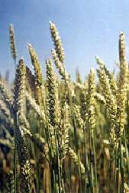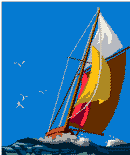

To send a message to an author, click on the author's name at the end of the article.
This Month in Ag Connection | Ag Connection - Other Issues Online

Hard white winter wheat is another alternative crop for consideration. It is grown and managed the same as our hard red winter wheat. The advantage is its improved palatability over red wheat products. The "red" description in wheat relates to the seed coat color. This also carries the flavoring, tannins and phenolic acid, characteristic to whole (red) wheat flour. Millers get around this by removing the seed coat, bran, and germ resulting in all-purpose white flour.
With white wheat, whole wheat flour can be produced without the flavors some people find objectionable. In bakery products, from breads to cakes, the characteristic color is much lighter and the flavor is much milder. Millers, bakers and consumers strongly prefer whole white wheat flour over whole red wheat flours. Advocates have been promoting whole grains for improving personal health from lowering cholesterol to increasing fiber in the diet.
There are already markets for white wheat. The use of white wheat is increasing. Foreign markets like Japan are buying more white wheat. About one-half of the world consumption of wheat is in the form of noodles. Flour from whole "red" wheat is less desirable for making noodles.
On the negative side, the hard white wheat Heyne was grown in a 1999 Missouri variety test. It yielded lower than other varieties. Research from Kansas showed white wheat varieties were more prone to sprouting damage during cool wet preharvest conditions.
With all alternative crops, markets should be researched and confirmed well before planting begins. Some of the varieties of hard white winter wheat available are Arlin, Betty, Heyne, Lakin and Trego.
(Author: Jim Jarman, Agronomy Specialist)
This Month in Ag Connection | Ag Connection - Other Issues Online
The office quick test is a qualitative test. The test is designed for determining when the level of nitrate detected in corn could possibly cause nitrate poisoning in livestock. If high levels of nitrate are indicated, growers are urged to send samples for accurate laboratory analysis before feeding corn as silage, greenchop or graze.
This sample should be a composite sample taken from at least four areas in the silo, trench, bag or bale. Pack the sample (approximately 5 lbs.) in a plastic freezer bag.
Samples should be taken or sent immediately to the laboratory. If transit time is more than a few hours or will be sent overnight, freeze the silage sample to minimize bacterial action. Otherwise, the nitrate test results will be lower than in the feed offered to livestock.
Nitrate test cost is $15.00 per sample. Lab forms are available at Extension offices or by printing from the Veterinary Medical Diagnostic Laboratory website.
Address for delivery (UPS, FedEx, etc.):
Veterinary Medical Diagnostic Laboratory
1600 E. Rollins Street
Columbia, MO 65211
Phone: 573-882-6811 or 800-862-8635
Fax: 573-882-1411
http://vmdl.missouri.edu/
For a few dollars more, you can obtain a complete analysis of your forage at other laboratories.
(Author: Rich Hoormann, Agronomy Specialist)
This Month in Ag Connection | Ag Connection - Other Issues Online

This fall after the crops are in the bin, you are thinking its time to get away from the farm for a few days. About that same time you see an ad in one of your farm magazines promoting a farm management conference being held on a 5-day ocean cruise. Combining business and pleasure sounds good, but will "Uncle Sam" allow you to deduct any of the cost for the business portion of this cruise? The short answer is yes, up to $2,000 per taxpayer per year. However, the long answer is that there are several stipulations and of course, the "i's" must be dotted and "t's" must be crossed.
First a little information about cruises:
Nine out of 10 people who have taken a cruise indicate they'll cruise again. So, given the above, it is understandable that Uncle Sam is just a little suspicious of whether this type of trip is really taken with a business motive. So here is the list of the "i's" and "t's". The sponsoring organization is actually responsible for some of these requirements and they should be able to help you with the other requirements.
So start looking for those business cruises, get your ducks in a row and smooth sailing.
(Author: Parman R. Green, Ag Business Management Specialist)
This Month in Ag Connection | Ag Connection - Other Issues Online
Corn silage from drought-stressed corn is excellent livestock feed, although several management issues must be considered. Nitrates can be an issue, although ensiling reduces nitrates 30 to 50 percent.
Once the ensiling process has completed and the silo is opened for feeding, other management issues need attention. Since drought damaged silage can vary greatly in nutrient content, it is recommended that a nutrient and nitrate analysis of the ensiled material be obtained. Then proper diets can be formulated based on the energy, protein and nitrate content of the silage.
When silage feeding begins during hot weather, it is recommended that at least 6 inches of silage be removed from the face of the pile daily in order to prevent silage deterioration due to oxygen exposure.
Book values for energy, represented by Total Digestible Nutrients (TDN), and crude protein (CP) for several feeds are listed on a dry matter basis in the table below.
| Feedstuff | % TDN | % CP |
|---|---|---|
| Fescue Hay, mature |
50 | 8.4 |
| Corn Silage, normal |
70 | 8.0 |
| Corn Silage, drought damaged |
61 | 11.1 |
Note that drought-stressed corn silage has over 20% more energy than mature fescue hay and nearly 40% more protein than normal corn silage.
There are several ways drought-stressed silage can be incorporated into the feeding program. A full feed (approximately 90 pounds) of as-fed silage provides excess energy to spring-calving cows of moderate body condition in late lactation. This level of feeding will result in cows gaining about 1 pound per day, but will meet the protein, calcium and phosphorus requirements of the animal.
Spring-calving cows of moderate body condition in late lactation will have their energy requirements met by feeding approximately 70 pounds of as-fed drought silage (or 24 pounds of silage on a dry matter basis). This is well below the expected intake of the animal and the protein and phosphorus requirements of the animal are not met. Other feedstuffs, such as hay or pasture, can be used to make up the difference in expected intake and will provide needed protein and minerals.
Weaning the calf has a dramatic impact on the nutrient requirements of the cow. For example, a spring-calving cow in moderate body condition but not lactating will have her energy requirements met by feeding approximately 50 pounds of as-fed drought silage, compared to the 70 pounds of drought silage needed for the lactating animal. Additional protein and phosphorus are still needed, but 50 pounds as-fed silage is only about 60% of what we would expect her to eat per day. Needed nutrients can easily be obtained with additional feedstuffs.
Other feeding programs to consider during this drought include combinations of silage, hay and supplement or limit feeding high concentrate diets. Supplements or high concentrate diets can be made using corn grain, soybean hulls, corn gluten feed, wheat midds, distillers grains and other by-product feeds. Various combinations of these feedstuffs can be utilized along with pasture, hay or silage. If hay is in short supply, ammoniated wheat straw is a viable feedstuff. When total feed supplies are low weaning the calves is probably the simplest and easiest way to reduce total forage needs for the cow herd.
Pay attention to the details of alternative feeding programs during this drought. There are many alternative management strategies for coping with the situation, but care must be taken to ensure the animals' nutrient requirements are being met. Your regional livestock specialist can assist you with these details or to provide additional information on the management issues discussed in this article.
(Author: Gene Schmitz, Livestock Specialist)
This Month in Ag Connection | Ag Connection - Other Issues Online
University of Missouri Extension specialists have begun searching for the western bean cutworm (WBC) and have found them in the central Missouri region. Pheromone traps are being monitored to keep track of the WBC.
Known as a pest of dry edible beans in the western states as far east as Colorado, this pest has been on the move. It is now recognized as established in Kansas, Nebraska, South Dakota, Minnesota and Iowa.
The main concern is WBC damage to corn and soybeans. It feeds as a pod worm on soybeans and as a whorl and earworm feeder on corn. Infestations are typically seen during the late growing season. In states where this pest is established scouting begins mid July. Moths continue to fly and lay eggs until mid August.
Most Bt transgenic hybrids will not control WBC. Research at the University of Missouri will be needed to confirm the levels of resistance in transgenic hybrids, economic thresholds for soybeans and corn and the most effective insecticides.
Watch for more information on this pest.
(Author: Jim Jarman, Agronomy Specialist)
This Month in Ag Connection | Ag Connection - Other Issues Online
Publishing Information
Ag Connection is published monthly for Northeast and Central areas of Missouri producers and is supported by the University of Missouri Extension, the Missouri Agricultural Experiment Station, and the MU College of Agriculture, Food and Natural Resources. Managing Editor: Mary Sobba.